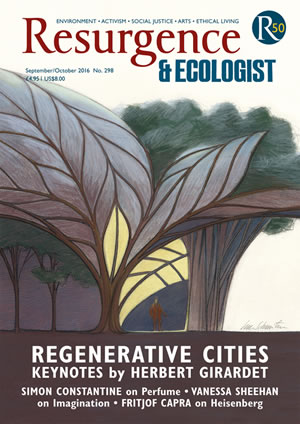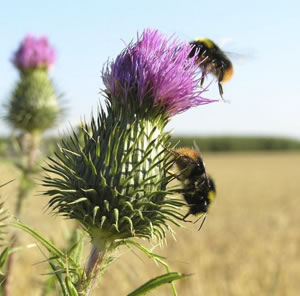The hypnotic buzz of bees in flower-filled meadows is one of the sounds redolent of the British countryside. But for how long?
Today’s agricultural landscape of intensive arable monocultures, “improved” grassland, derelict hedgerows and slurry pits all too often resonates with nothing more poetic than the dull grumble of tractors drenching the fields with toxic cocktails of pesticides. The modern countryside has become increasingly silent, bereft of the song of the nightingale, the call of the cuckoo, the rasping cry of the corncrake: made hostile to the wildlife that we took for granted just a generation ago.
It’s not just the chemicals. We have ripped up and drained our ancient herb-rich meadows, permanent pastures and rough grazings – like the culm grasslands of Devon – that have provided a centuries-long home to a huge diversity of flora, together with wild birds, mammals and a broad assemblage of insect and invertebrate life from bees to butterflies. A long process of ecological decline is under way. Piece by piece, our countryside is losing its colour, diversity, richness and resilience.
One particular group of insects – bees – is faring especially badly, perhaps because they’re a canary in the coalmine for the health of our native ecosystems. The UK has lost 20 species of wild bee since 1900, a further 35 are under threat of extinction today, and for years bee colonies have been dying out at an alarming and unsustainable rate.
Their specialist needs – for flowers, nectar, pollen, and undisturbed habitat in which to build their nests and hives – make them a sensitive indicator of ecological health. So too does their vulnerability to agrochemicals, in particular the neonicotinoid insecticides – ‘neonics’ for short – increasingly popular among farmers, who are spending about £1.5 billion on the chemicals worldwide.
There’s a huge body of scientific evidence that links neonicotinoids to bee colony decline, including both honeybees and, more especially, wild bees. Scientists have found that the chemicals can kill bees outright at the concentrations used in farming, but, no less worryingly, that at much lower doses they damage bees’ immune systems and impair their ability to navigate and remember the locations of hives and flowers. These findings led to the European Union’s Regulation 485/2013, approved in 2013, restricting the use of neonics in seed dressings due to the unacceptable risk they pose to Europe’s bees.
Then it got worse: in July 2014 evidence emerged that neonicotinoids are damaging much more than just bees: the toxic impact of the chemicals ripples through the entire farmland ecosystem, taking in not only bees but also earthworms, birds and aquatic invertebrates, exposed to the high levels of chemicals that concentrate in groundwater, ponds and ditches.
According to the Worldwide Integrated Assessment of the Impact of Systemic Pesticides on Biodiversity and Ecosystems, a four-year study by The Task Force on Systemic Pesticides, “a compelling body of evidence has accumulated that clearly demonstrates that the wide-scale use of these persistent, water-soluble chemicals is having widespread, chronic impacts upon global biodiversity and is likely to be having major negative effects on ecosystem services such as pollination that are vital to food security.”
Co-author Jean-Marc Bonmatin of the National Centre for Scientific Research (CNRS) in France observed: “The evidence is very clear. We are witnessing a threat to the productivity of our natural and farmed environment equivalent to that posed by organophosphates or DDT. Far from protecting food production, the use of neonicotinoid insecticides is threatening the very infrastructure which enables it.”
Another worrying discovery followed last October: the neonics are expressed at much higher concentrations by wild flowers in field margins and hedgerows than in crops that have been sprayed or seed-treated with the insecticides. Scientists from the University of Sussex found that wild flowers such as poppies, hogweed and hawthorn blossom contained around five times more neonics than a treated oilseed rape crop, with even greater levels found in wild flower pollen.
As a result, said the authors, “the large majority (97%) of neonicotinoids brought back in pollen to honey bee hives in arable landscapes was from wildflowers, not crops. Both previous and ongoing field studies have been based on the premise that exposure to neonicotinoids would only occur during the blooming period of flowering crops and that it may be diluted by bees also foraging on untreated wildflowers ... [but] exposure is likely to be higher and more prolonged than currently recognized due to widespread contamination of wild plants growing near treated crops.”
And it’s not just bees that are at risk: at these elevated levels neonicotinoids can also harm other wild pollinators, caterpillars and bugs living near arable fields, eroding the entire agro-ecosystem. All this makes one of our standard responses to habitat loss – planting flower-rich field margins to help sustain pollinators – inadequate in the extreme: ‘wildlife-friendly’ field margins could actually help to poison, not protect, our bees and other insect life.
So how has the British government responded to the neonic threat? First, it fought hard against Regulation 485/2013, as it revealed to the Environment Audit Committee: “We opposed these restrictions because our assessment was (and remains) that evidence did not point to risks to pollinators that would justify restrictions.” Its position followed that of the National Farmers’ Union (NFU), which holds that neonicotinoids are essential to combat cabbage stem flea beetle on oilseed rape crops.
Last year the NFU applied for a derogation to allow farmers to use neonicotinoids on autumn-planted oilseed rape, claiming that under the regulation it was “becoming nearly impossible for many farmers” to grow the crop. It surprised no one when Defra, the Department for Environment, Food and Rural Affairs, permitted farmers to plant neonic-treated oilseed rape on 30,000 hectares of arable land, some 5% of the English crop.
But then something happened that strongly suggests there’s no need for the neonic-treated seed at all: England’s 2015 oilseed rape harvest – 100% planted with untreated seed – delivered a bumper crop. Winter yield was 13% above the 10-year average, while spring yield was up 25–30%.
Yet despite this, the NFU applied for an even larger derogation for autumn 2016, applying to plant 195,000 hectares of neonic-treated oilseed rape, about a third of the crop. This time Defra turned down the application flat. Does that refusal indicate a change of heart? Possibly. Or possibly not: its decision followed a devastating critique by Defra’s official adviser, the UK Expert Committee on Pesticides (ECP), so detailed and specific in its dissection of the NFU’s application that any other response would surely have been met with a legal challenge.
After that the NFU submitted further applications covering a smaller area, and the decision came through just as this magazine was going to press: another refusal. According to a Defra statement, the ECP “found that neither of the applications met the requirements for emergency authorisation”, and both were therefore rejected. NFU vice president Guy Smith complained of a “bitter blow”; but Dave Timms, bee campaigner with Friends of the Earth, said it was “great news for bees and other wildlife”.
Good news for British bees and the wider ecosystem, then, and a welcome sign that Defra is at last standing up to agro-industrial interests that all too often get their own way. But we shouldn’t be too excited. Another threat to Britain’s environment, and the bees, looms following the Leave vote in the UK’s EU referendum in June. In the event of a full extrication from the EU, the UK would no longer need to comply with EU directives, including the twin ‘Nature laws’, the Birds Directive and the Habitats and Species Directive, which together form the foundation of our wildlife protection.
But would the government actually want to get rid of its Nature protection laws post Brexit, or weaken them? “The birds and habitats directives would go,” said the farming minister, George Eustice, shortly before the referendum, describing them as “rigid” and “spirit-crushing”. Instead he wants to replace them with more flexible laws and voluntary certification schemes. “If we had more flexibility, we could focus our scientists’ energies on coming up with new, interesting ways to protect the environment, rather than just producing voluminous documents from Brussels,” he told the Guardian.
There’s also good reason to be concerned about genetically modified crops and their impacts. Former Conservative environment secretary Owen Paterson has denounced the EU for holding back the advance of GM crops, levelling charges of “ecoterrorism” and even “witchcraft” at environmental campaign group Greenpeace for its opposition to the technology – indicating a possible post-Brexit direction of travel.
And to judge by the experience of the US, Argentina, Brazil and Paraguay, GM crops could do serious damage to our wildlife. ‘Roundup-ready’ GM crops resistant to the herbicide glyphosate are implicated in the dramatic collapse of North America’s migratory monarch butterfly, which relies on the once-common milkweed as its main food plant. Milkweed has now been eliminated from huge areas of the US by the massive spraying of glyphosate associated with ‘Roundup-ready’ crops – and something similar could happen here with our own farmland weeds and wild flowers that sustain wild bees and other pollinators.
Insecticidal GM crops that express insect toxins of bacterial origin in their leaves, nectar and pollen represent another hazard to bees and other insects. Studies have shown that these toxins, engineered into maize, cotton, aubergine and other crops, can affect ‘non-target’ species such as bees and butterflies.
Our bees face other threats too: Varroa mites, around 20 known viruses (many of them transmitted by Varroa), and cool, wet summers, possibly connected to climate change. About one in six of Britain’s honeybee colonies died in the winter of 2014/15, according to the British Beekeepers Association (BBKA), and a third two winters before. Losses increased last winter to around one in five, the latest figures show – perhaps a consequence of the poor 2015 summer, which saw honey yields fall from 14.5kg to 9.5kg per hive.
“These rates of loss are unacceptable,” Tim Lovett of the BBKA told Resurgence & Ecologist. “We have to guard our bees carefully, and what’s bad news for honeybees is even worse for others, the solitary bees and bumblebees: at least the honeybees have keepers running around trying to make things better for them. This matters to us all because every third mouthful we eat depends on insect pollination, including many of the foods we most enjoy.”








